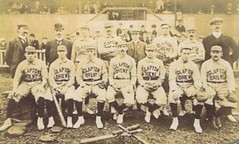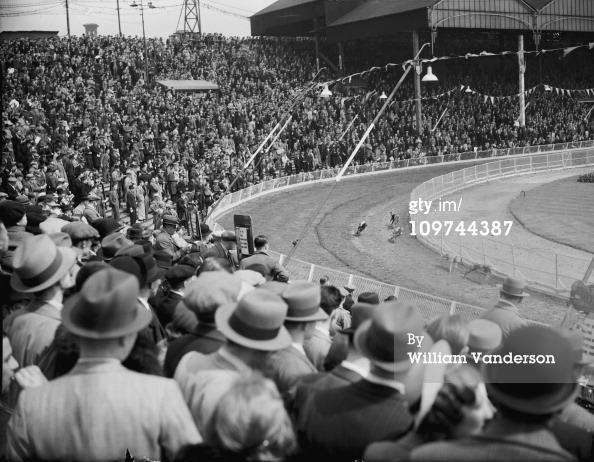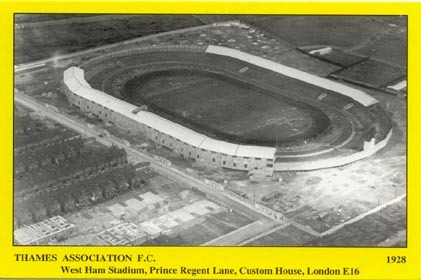A Tale of Two Stadiums Clapton and Hackney Stadiums
Charles Dickens wrote a ‘A Tale of Two Cities’. Welcome to the ‘Tale of Two Stadiums’
It’s hard to believe Clapton Stadium was redeveloped for greyhound racing in1928 and yet only 4 years later, just over two miles away, Hackney Wick Stadium was to open and stage dog racing. Two fascinating articles taken from the archives site of www.hackney.gov.uk and www.footballspeak.com
Both provide the stories of two stadiums within a stone’s throw from each other.
Click here to see Clapton Football Stadium in Millfields Road before the introduction of greyhound racing .
Click here to see Hackney Wick Stadium in 1934 a year before the intoduction of speedway
Click here to see Hackney Stadium as most of us remember it.
Artical by Sally England
GREYHOUND racing was one of Britain’s most popular spectator sports in its 1940s heyday, with 77 licensed tracks across the country, attracting over 50 million visitors each year.
Two of these tracks were in Hackney at Millfields Road in Clapton, and Waterden Road in Hackney Wick. Clapton Stadium originally opened as Whittles Athletic Ground, and was a venue for whippet racing, but its main use became football when Clapton Orient (now Leyton Orient) moved there in 1869. The site was redeveloped and renamed Millfields Road.
The greyhound facilities were designed by engineer and architect Sir Owen Williams at a cost of over £80,000, opening in April 1928 as London’s fourth greyhound stadium, just two years after the first British race was held at Belle Vue, Manchester.

Above 1932 Underground Advert
A restaurant was added in 1930, with a second built in 1939, as well as covered stands.
Waterden Road opened four years later in 1932 and, like Millfields Road, was home to more than one sport: greyhound racing and speedway. The original stands could hold 10,000 spectators, increasing to 15,000 in 1953.
The oval track was known for its long straights and easy bends, while the track at Clapton was shorter and almost circular, with wide bends that made it one of the fastest in the country. Because of this, Millfields Road became the permanent venue for one of the most important classic events in the sport, the 400 yard Scurry Gold Cup.
Greyhound racing appealed to working men in particular, as the entry fee was cheaper than horse racing, and the venues were easier for an urban population to get to.
It was also the only place that many people could enjoy a legal flutter, when lack of money meant that obtaining credit at a bookmakers’ was impossible.
Changes in gambling legislation led to the gradual decline of the sport however. When betting shops opened in the mid-1960s it became possible to gamble on a race without being at the venue, a trend that has increased since, with bookmakers able to stay open late and gambling on the internet.
Because dog races last only a matter of seconds, they did not prove to be good television, and the profile of the sport suffered.
The rise of alternative forms of entertainment has meant that only greyhound tracks that focussed on offering additional attractions, such as restaurants and party facilities, have survived.
The Greyhound Racing Association bought the Millfields Road stadium from its shareholders in 1967, but sold it again only two years later. Clapton struggled on for a few more years, with the final race held on 1 January, 1974. The stadium was eventually demolished and the site used for the construction of Millfields estate.
Waterden Road remained unchanged and much-loved for many years. Then in the 1990s a huge redevelopment plan was announced to turn the venue into a multi-million pound stadium for the 21st century, open six nights a week.
But this was before Hackney Wick was transformed for the London 2012 Games, and there were problems with transport links to the new attraction.
The stadium opened in October 1995, but went into receivership the same night and closed only 14 months later in January 1997.
The site was bulldozed in 2003 as work progressed on the London 2012 bid, the success of which ultimately brought all the connections and facilities the Hackney Wick stadium had needed to survive, only years too late.
Today only the Wimbledon dog track survives in London, with just 24 registered stadiums elsewhere, along with some independent venues.

Artical below taken from
Click here for www.footballspeak.com

Records of attendances at the Millfields prior to 1913 are hard to come by, however there are suggestions in many quarters that the club’s far more successful Baseball side (above) had gone some way to subsidizing the Football club’s existence. In 1906 several top-level Football sides, including Woolwich Arsenal, Tottenham and Derby County, had formed the British Baseball Association as way of generating revenue during the summer months. The popularity of Baseball in Clapton had been so considerable that they were National Champions for two seasons out of three between 1907 and 1909. A rare instance of the Football side turning out huge crowds had been at the end of the 1914-15 season, when 22,000 fans turned up for the visit of Leicester Fosse as a send-off for the 41 members of staff and players who had signed up en mass to join the forces fighting the Great War.
The four year break enforced on Football between 1914-18 greatly affected Orient’s finances. There had also been post-war expansion of the Football League after 1919 which saw West Ham and Millwall both elected to the League and eroding Orient’s East End monopoly on Football League, as well as the aforementioned two sides’ proximity to the Docks which would eat up the potential attendances for Dockers seeking post-work entertainment after finishing their half-day Saturday shifts. Also, it was not so much Arsenal’s arrival in North London which affected Orient’s progress, but Herbert Chapman’s in 1925. Orient attempted to rebuild the Millfields Stadium around the same time as Arsenal had begun to flourish in the North Eastern corner of London and, as a result had restricted their potential gate receipts.
By 1927 Orient were still greatly in debt as a result of their re-development plan and could therefore not afford to purchase the expired freehold on the Millfields Stadium from the local council. The site was eventually sold to a syndicate headed by Lady Amherst, who had intended to convert the Stadium for use as a Greyhound Racing track – later to be renamed as Clapton Stadium (Below). Also, in the late 1920s Arsenal had bought into Orient with the intention of using the club as a nursery side for the development of young players, until the FA outlawed such a practice leaving Orient in some considerable financial difficulty without Arsenal’s cash injection.



Despite the intentions of the new owners of the Millfield Stadium, Clapton Orient continued to lease the ground. However the new landlords looked to coerce the tenants out, forbidding their use of the pitch for training and the extra expense that was incurred in renting a separate site elsewhere. Orient’s directors were also denied the use of the board-room on match-days. By 1930 the club moved to a stadium in Lea Bridge Road, which doubled up as a Speedway arena. Due to its dual purpose, the stadium had a wooden fence around its perimeter. The Football League had received complaints that the fencing was too near to the touchline and were ordered to extend the narrow pitch. Also, a rare large crowd of 20,000 for the visit of Millwall had also resulted in pitch invasions due to overcrowding. Orient soon became aware that the Lea Bridge Road Stadium was not fit for purpose. As a result they had used Highbury and even Wembley as a temporary solution. By 1937 they decided to ground share with cash strapped side Leyton Amateurs at Brisbane Road and have remained there ever since, changing their name to Leyton Orient in 1946.
The Orient’s historical subordination as a club to the interests of sports such as Baseball, Greyhound Racing and Speedway gives some insight into the kind of competition that professional football in East London faced in the first half of the twentieth century. In 1927 the West Ham Stadium (below) was built near Prince Regent Lane in the Custom House area and with a capacity of 120,000 was at that point the largest stadium in England. The Stadium acted as a home ground for the West Ham Speedway Side, as well as hosting Greyhound Racing. Both events took place during the week; however the Stadium owners had wanted something to generate revenue on the weekends and hence had formed Thames Association FC. It may well sound a slightly odd concept to found a side purely to fill a stadium, however this is exactly how Chelsea F.C. were formed in 1905 in order for businessmen Gus and Joe Mears, the owners of the leasehold of Stamford Bridge, to host Football games at what had been mainly an Athletics Stadium for nearly 30 years prior after Fulham had turned down their initial offer to occupy the Stadium.

The idea of Thames Association F.C. however didn’t prove to be a successful one. The side had been elected to the Football League Third Division South in 1930, however in their two seasons in the league had finished in the bottom three on both occasions. They also struggled to attract the crowds to sustain league football, averaging just 2000 fans per game and had achieved an all-time record low attendance of just 469 for their game against Luton Town in December 1930 – which is an incredibly small size crowd for a Stadium that was actually bigger than Wembley. After finishing rock bottom in 1931/32 the club had refrained from seeking re-election. They had also turned down the offer of a merger from a Clapton Orient side desperately seeking an adequate stadium and subsequently folded. The West Ham Stadium itself continued to exist for the purposes of Speedway, Greyhound Racing and later Baseball and Stock Car Racing. After the war however attendances for Sports meetings – particularly the kinds of Sports which previously filled the Stadium, had dwindled due to new forms of entertainment, such as Television. West Ham Stadium eventually became obsolete and was demolished in 1972 to make way for a housing estate – and maybe after the Olympics is a timely reminder of what can happen to a previously grandiose stadium if not filled by a reasonably large Football side, with a reasonably large existing fan base, on a regular basis.


Above an aerial view taken in December 1945 shows Clapton Stadium

Above an aerial view taken in 2013 showing the site now where Clapton Stadium was.
|